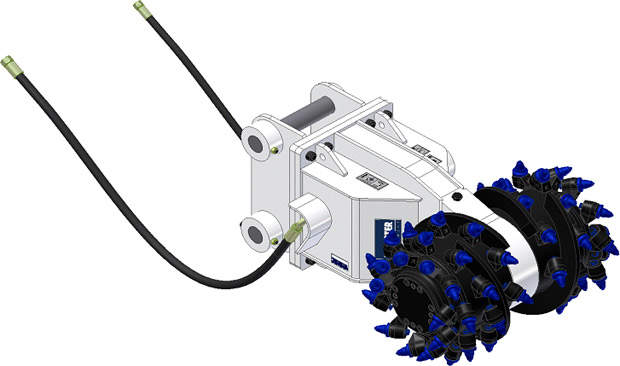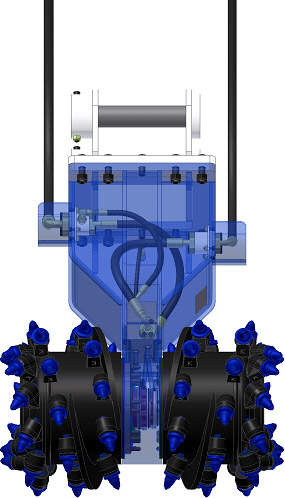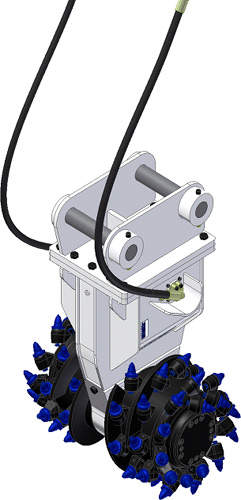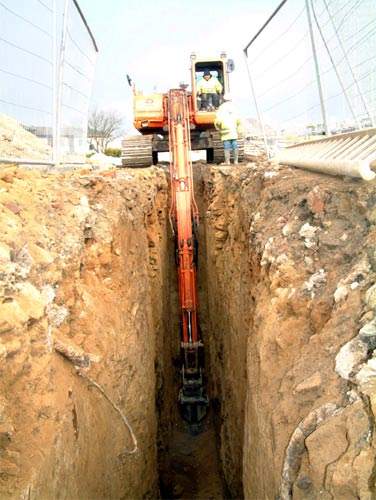Webster Technologies Ltd is an engineering design and consultancy company that specializes in the development of hydraulic cutting machinery for the construction, mining, tunnelling and nuclear industries. The company recently launched the Webster
Rock wheel range, a series of hydraulic excavator mounted attachments (otherwise known in the industry as rotary cutters or transverse cutting units).
TD ROCKWHEEL – HYDRAULIC EXCAVATOR
After developing the first reliable gearbox design for Transverse Cutting Units (TCU), now an industry standard and used by a number of competitors, Webster Equipment has released its new improved TD Rockwheel range. Webster was the first to develop a
hydraulically driven cutting system and have over 40 years experience in the mining and construction industries. The cutting drums are designed to give the optimum performance in soft to medium strength rock.
The TD-100 Rockwheel features a direct drive design. A high torque low speed hydraulic motor is mounted in between the two cutting heads, each of which has its own bearing assembly. A high powered motor is selected to suit the hydraulics for the
selected excavator range with a torque range capable of giving the maximum pick forces possible. The set up process is now made much easier when matching the unit to the excavator’s hydraulic power band.
Each unit has two cutting drums mounted on a transverse shaft driven either through a gear train, or directly, by a hydraulic motor powered and controlled from the excavator’s auxiliary hydraulic circuit.
The cutting units are individually sized for output torque, pick force, pick speed and excavator weight. Cutting heads can also be supplied with water injection for dust suppression, or water jetting to assist cutting.
In addition to use in the mining, tunnelling and construction industries, transverse cutting units have established themselves as the ideal excavation attachment for cutting the hard materials encountered in the civil engineering and public works
sectors including cutting unreinforced and reinforced concrete, rock, tarmac.
The Rock wheel range is suitable for use in the following environments / applications:
- Tunnelling
- Shaft sinking
- Building renovation
- Underwater
- Roadwork
- Demolition
- Frozen ground
- Tree stumps
HYDRAULICALLY DRIVEN CUTTING SYSTEM
The unit has its own hydraulic valve assembly incorporated within the body of the unit. The valve protects the excavator and hydraulic motor from pressure spikes during start up, increasing the potential life of the motor. The valve also allows the TD
range to be operated without the need for a separate motor drain line, simplifying set up, reducing cost and making it easier to switch between excavators.
Hydraulic problems can be diagnosed quickly with a relief to atmosphere indicating that there is a problem with the circuit. Hydraulic motor failures can prove costly to the excavator’s hydraulic circuit – this valving will help to prevent such
failures.
Heavy duty seals and bearings are used to cope with arduous conditions and cutting drum replacement is quick and simple. Underwater operation is possible to 30m depth.
The Rockwheel is seen to be more flexible when considering bespoke designs. Webster Equipment is working with its dealers to further explore the potential for using cutting technology as opposed to hydraulic breakers.
The Webster Rockwheel provides the plant operator with a robust and versatile cutting facility which can quickly be attached to the bucket linkage of an excavating machine to provide a hard dig capability, combining robustness, simplicity, flexibility
and reliability.
Key benefits:
- Low operational noise and vibration transmission into the ground
- Improved excavation output when compared with other commonly accepted hard dig attachments
- Can be controlled to cut an accurate profile





